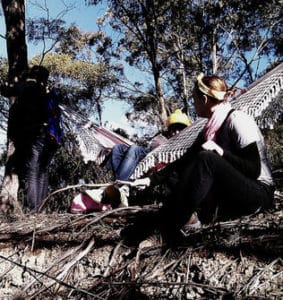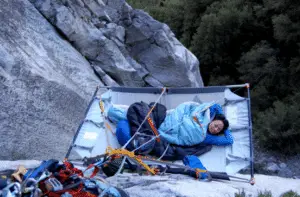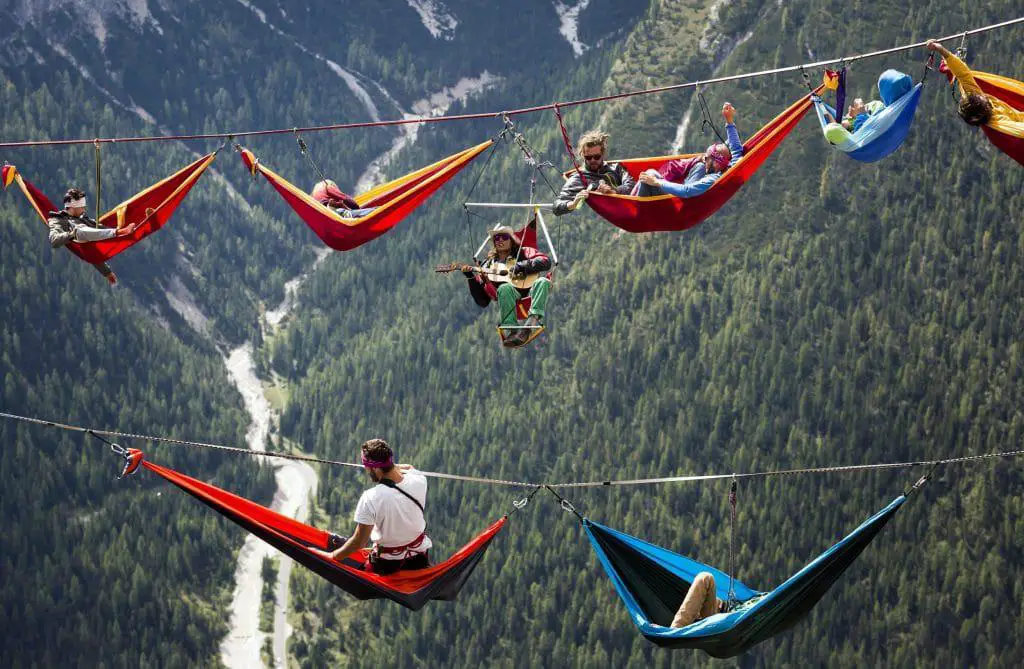
Important disclaimer: While this should be obvious, we have to make sure that we see all of us here at amazingoutdooradventures.com are not advocating any risky or unsafe practices. We believe that extreme hammocking is is an awesome topic, a really cool part of the outdoor enthusiast space, and we wanted to talk about it. This article is informational purposes only. If this seems interesting to you do it right: join communities, always be safe, and take responsibility for your safety. We are not legally liable.
My brother and I have a wide and eclectic love of the outdoors. Sometimes what we cover is because it’s something we have always loved (barbecue, fire, hiking, etc), sometimes it’s because of something really new or interesting, and sometimes it’s interesting and yet a great big NOPE!
Look, I know my limits. As one friend put it “You’re a ridiculously agile and fit keg with two tree trunks for legs.” That’s not conducive to swimming, although I’m very good at floating sinking. I’m not huge on heights. Hike up a mountain for a great view? Sure. Extreme hammocking?
I admire and salute all of you outdoor adventurers who are into this. But the vertigo…dear Lord man. This is one of those high adrenaline, high adventure activities that isn’t going to be for everyone (and I can openly admit I’m one of those people) but it’s incredibly interesting and definitely worth looking at…if for no other reason than some absolutely amazing pictures.
(Note: We really love some of these photos. If you have a few from your own extreme hammocking experience you’d be willing to let us use, please let us know. We’d be happy to feature you in the caption and bring attention to your photography work.)
Table of Contents
How To Get Started Hammocking

There’s obviously a big difference between your conventional hammock camping and what falls into the category of “extreme hammocking.” Generally speaking even if you are really into extreme adventures and the type of outdoor activities that you might find in the X-Games, you’ll want to start with becoming comfortable with hammocks much closer to the ground before scaling cliffs, hanging off the bottoms of old iron bridges far above the river below, or specifically set up on high lines that are there just to give the adventure junkies a way to really hang around and get absolutely breath taking pictures, as well.
The feature image for this article is a great example of one of those lines, but there are many other examples. Whether finding a great place around a bridge, stacking them up between two trees layer after layer until the top hammock is 30-40 feet up, or creating three incredibly long guide lines that come together for a hammock over a large ravine, there are actually many different ways to enjoy a hammock out in nature, and finding a local community of outdoor adventure enthusiasts into the same type of thing will help further increase those ideas of where you want to hang out for your next stunning Instagram pic.
It’s also worth noting that “extreme” hammocking means different things to different people. For some hanging the hammock 20 feet off the ground or around bear bag height qualifies. Other people don’t consider the hanging in hammocks to be extreme unless they’re 100 feet up handing from a bridge’s underside, hundreds of feet in the air over a valley, or somewhere similar hanging from amazing heights thousands of feet off of a line stringing between two mountains.
Then you have others who knit their own hammocks and places, like this BYU article talks about when exploring one aspect of this remarkable outdoor activity as pushed forward by Andy Lewis, aka “Sketchy Andy” (great nickname, btw). Weaving your own “space nets” for hammocking in extreme heights over the canyons, anyone?
Looking at top notch hammocks
Most of the time we always recommend going for the absolute best quality outdoor gear anyway but when you’re going to be setting up to hang over a canyon, a waterfall with a steep drop, or even really high up between two trees, you want to make sure your hammock is made from top notch materials and methods.
This is doubly true if you are going to be getting into extreme hammocking. When you are hanging at a height that means death if you fall unsecured, you don’t want to leave anything up to chance. This is why taking all proper precautions at every level for safety is crucial so if one safety features fails, another kicks in. That includes looking at the quality of equipment and not all hammocks are created equal!
In other words you don’t go cheap if you are going to be hanging hundreds or thousands of feet above a sheer drop.
There are some very experienced outdoor adventurers who are used to making their own hammocks or webbing to hang from, and while that is certainly a valid option for someone who really knows what they’re doing, this is definitely NOT something newbies should be trying out especially when pushing towards the more extreme version of hammocking.
Just a short list of some of our favorite high quality camping hammocks include:
- Wise Owl Outfitters (WOO) hammocks
- Eagles Nest Outfitters (ENO) hammocks
- Or take a look at our best hammocks article for more
Be a Hammocking Expert First!
You need to crawl before you walk and walk before you run, and many things in life are no different. This is one of them. If you are an old hand at learning how to hammock camp then you are already on the right path. If you are a major slackliner to boot then you are probably ready to move into extreme camping.
However if several of these terms are relatively new to you then you need to spend some time in the woods and set up some low level beginner slacklines before you try to jump to the next level. Extreme hammocking is definitely not for everyone, but for those it speaks to this is still a process that starts with learning the very basics and moving out and up from there.
Even if you have all the prerequisite skills, always look at connecting with a community. There are so many important things that go into enjoying this sport safely from technique and skill to equipment to learning and understanding the processes for setup, for hitting a place, and for safely enjoying the natural thrills that are present from such an interesting and extreme outdoor activity.
Having a little bit of guidance isn’t just smart, but one of the best benefits of diving into extreme hammocking is the tightly knit (sadly, pun intended) community that you will then become a part of.
How Did Extreme Hammocking Start?

Depends on which story you believe or how exactly you look at it. There are definitely some big names within this community, but different groups are doing very different things and that’s just with modern hammocks and parachute camping hammocks.
If you’re going the original route similar to what the great BYU article we linked to earlier was about, then the number of options continue to open up. Anyone who spends a lot of time doing serious climbing or slacklining is going to understand how these lines need to be run for safety’s sake and getting into extreme hammocking can make sense as a very natural transition
The truth is that hammocks have been around for centuries, and chances are that this isn’t the first generation of thrill seekers who had ideas about hanging out where the views were amazing and most annoying (and sometimes dangerous) ground animals couldn’t reach them.
That being said the idea of extreme hammocking as a practice in and of itself is a relatively new phenomenon. The idea, however, is not.
Serious rock climbers understand how this works
As anyone who has spent two or three days climbing a sheer rockface can tell you, hanging around is sort of a way of life if you are going to challenge the big climbs. Whether stopping for a meal, a rest, or sleeping for the night, you’re going to be looking at rock face camping or “Port A Ledge” sleeping arrangements, as you can see from the last picture that was posted.
While this isn’t the same thing as extreme hammock camping, it does precede it with the tradition of hanging, camping, and sleeping from huge heights and very unusual places. While this might not be a mainstream practice for many outdoor enthusiasts, it goes to show that resting or sleeping on the side of a cliff face has been around for a while, so it should be no surprise that the idea of putting up a hammock 400 feet over a valley would hit some groups as a fantastic way to spend at least part of the day.
Slacklining & Extreme Hammocking
There’s no denying that slacklining and extreme hammocking have definitely been related in how the two sports have developed. There are a variety of reasons for this, not the least of which is how the previously aforementioned “Sketchy Andy” being an ambassador for both and a major driving force. Not because he has recruited others into the life, but because of his passion for it and openness to showing what benefits can come from those experiences.
In fact, when you’re looking at many of the best pictures from extreme hammocking, many of them fall right in line with popping up a hammock or netting right where the most scenic part of a slackline walk would be.
Over a waterfall? Classic slackline practice.
Between two trees looking out over a valley or down on the forest floor? Common slackline practice.
Between two cliffs with a steep drop (and what a view) in both directions? You guessed it: common slackline practice.
The two truly do go hand in hand.
Find An Extreme Hammocking Community
There’s no question that finding a high quality community makes any outdoor activity in your area a lot more fun, and makes it much easier to consistently get out there. There are several places online where you can find a local extreme hammock community, and it’s worth checking them out. It is worth noting that because many of the people who love this extreme version of relaxing tend to be on the young, adventurous, and college-age side of things, online forums and the most popular social media spaces can change quickly.
Look around online as there are always great little communities popping up and then, yes, sometimes disappearing. However if you love slacklining, love extreme hammocking, love extreme sports period then look around and find where the activity is now – and join in!
Just a few good places to start include:
This Facebook Page for Extreme Hammockers
Extreme Hammocking YouTube Video
In Conclusion
Hey, this definitely isn’t going to be for everyone, especially those outdoor individuals who aren’t particularly that type of adventurous or those who hate heights and suffer from vertigo. While this isn’t going to be the biggest pull for me (and it’s probably a safe bet it won’t be a big pull for my brother, either) we know there are plenty of our readers who are going to love it and what to learn everything they can to get involved and get moving with their own hammock based outdoor adventures.
And as a final note I just have to say, it was insanely hard for me to go this entire article without making multiple bad puns and references to the Counting Crows song Hanging Around. But I am going to link it.
There’s only so much self control you can expect from me in any given post.

